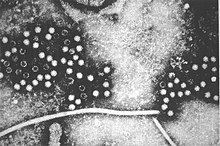Orthohepevirus
| Orthohepevirus | |
|---|---|

| |
| TEM micrograph of Orthohepevirus A virions | |
| Virus classification | |
| (unranked): | Virus |
| Realm: | Riboviria |
| Kingdom: | Orthornavirae |
| Phylum: | Kitrinoviricota |
| Class: | Alsuviricetes |
| Order: | Hepelivirales |
| Family: | Hepeviridae |
| Genus: | Orthohepevirus |
| Species | |
| Synonyms | |
Orthohepevirus is a genus of viruses assigned to the family Hepeviridae.[3] Orthohepevirus is a fairly isolated viral genus in which the virions are characterized by round, non-enveloped and isometric capsids with a diameter of 27–34 nm. The hepatitis E virus belongs this genus as the species Orthohepevirus A[3]
Genome
[edit]Orthohepeviruses have RNA genomes of 7176 nucleotides in length and infect vertebrates. Additionally, the genome is monopartite, linear, and single-stranded. The genome is 5' capped with a poly A tail at the 3' end. The genome possesses three main open reading frames. The first encodes non-structural proteins, the second encodes the capsid proteins, and the third encodes a small, multifunctional protein.[3]
Taxonomy
[edit]Viruses from this genus have been isolated from a variety of mammals (including rodents, mustelids and bats) as well as birds.[3][4][5] At least three variants of avian hepatitis E virus have been isolated from birds.[6]
A Hepatitis E-like virus has been isolated from a Swedish moose.[7] This virus is quite distinct from the other known Hepatitis E viruses.[3]
In total, the genus has four recognized species: Orthohepevirus A, Orthohepevirus B, which was previously known as the avian hepatitis E virus, Orthohepevirus C, and Orthohepevirus D.[3]
History
[edit]Hepatitis E was first isolated in 1990. It was thought to be restricted to humans until 1997 when it was isolated from pigs.[8] The first isolation from birds was in 2001.[9]
Evolution
[edit]One study has suggested that this species may have originated in birds and then spread to bats and other mammalian species.[4]
References
[edit]- ^ Purdy, Michael A.; et al. (June 2014). "New Classification Scheme for Hepeviridae" (PDF). International Committee on Taxonomy of Viruses (ICTV). Retrieved 1 May 2019.
The change from the current usage of Hepevirus to Orthohepevirus for avian and mammalian HEVs and Piscihepevirus for trout HEVs is used.
- ^ Chang, Sandra (17 July 2002). "Taxonomic Proposals from the ICTV "HEV-like viruses" Study Group" (PDF). International Committee on Taxonomy of Viruses (ICTV). Retrieved 1 May 2019.
- ^ a b c d e f "ICTV Online (10th) Report".
- ^ a b Drexler JF, Seelen A, Corman VM, Fumie Tateno A, Cottontail V, Melim Zerbinati R, Gloza-Rausch F, Klose SM, Adu-Sarkodie Y, Oppong SK, Kalko EK, Osterman A, Rasche A, Adam A, Müller MA, Ulrich RG, Leroy EM, Lukashev AN, Drosten C (2012). "Bats worldwide carry hepatitis E virus-related viruses that form a putative novel genus within the family Hepeviridae". J. Virol. 86 (17): 9134–47. doi:10.1128/JVI.00800-12. PMC 3416139. PMID 22696648.
- ^ Marek A, Bilic I, Prokofieva I, Hess M (2010). "Phylogenetic analysis of avian hepatitis E virus samples from European and Australian chicken flocks supports the existence of a different genus within the Hepeviridae comprising at least three different genotypes". Vet. Microbiol. 145 (1–2): 54–61. doi:10.1016/j.vetmic.2010.03.014. PMID 20399575.
- ^ Zhao Q, Sun Y, Zhou E (2012). "[Detection and description of avian hepatitis E virus isolated in China—a review]". Wei Sheng Wu Xue Bao (in Chinese). 52 (3): 279–85. PMID 22712397.
- ^ Lin J, Norder H, Uhlhorn H, Belák S, Widén F (2014). "Novel hepatitis E like virus found in Swedish moose". J. Gen. Virol. 95 (Pt 3): 557–70. doi:10.1099/vir.0.059238-0. PMC 3929172. PMID 24296469.
- ^ Meng XJ, Purcell RH, Halbur PG, Lehman JR, Webb DM, Tsareva TS, Haynes JS, Thacker BJ, Emerson SU (1997). "A novel virus in swine is closely related to the human hepatitis E virus". Proc. Natl. Acad. Sci. U.S.A. 94 (18): 9860–5. Bibcode:1997PNAS...94.9860M. doi:10.1073/pnas.94.18.9860. PMC 23282. PMID 9275216.
- ^ Haqshenas G, Shivaprasad HL, Woolcock PR, Read DH, Meng XJ (2001). "Genetic identification and characterization of a novel virus related to human hepatitis E virus from chickens with hepatitis-splenomegaly syndrome in the United States". J. Gen. Virol. 82 (10): 2449–62. doi:10.1099/0022-1317-82-10-2449. PMID 11562538.
External links
[edit]
